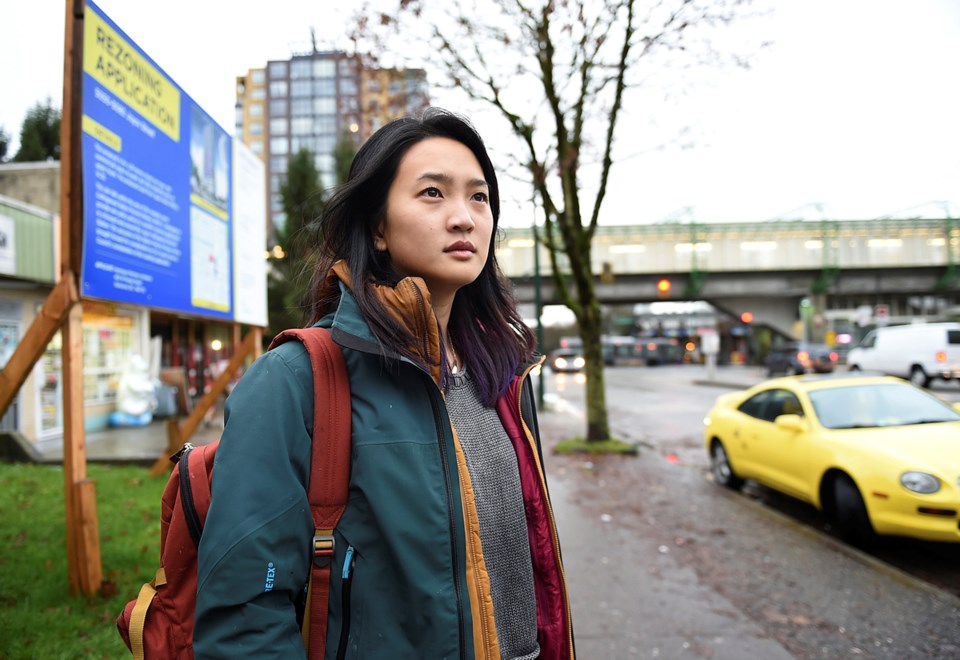Chanel Ly has lived in the Renfrew-Collingwood neighbourhood for more than a decade. Like many residents, she’s from a working-class family. Her parents are Chinese and Vietnamese and immigrated in the early ’80s. But 23-year-old Ly is concerned the community won’t be as affordable for families like hers in the future because the City of Vancouver is in the midst of a review of the area surrounding the Joyce-Collingwood SkyTrain station.
The review, initiated in December 2014, is looking at land use, density, building forms, transportation issues, how to improve public spaces and what amenities are needed to support the population, in pockets around the station.
The transit hub, which connects to the Expo Line and five bus routes, is being upgraded. Currently, it handles 30,000 SkyTrain trips and 12,000 bus trips a day.
The neighbourhood’s overall population has grown substantially over the years — it jumped from 6,260 in 1986 to 16,836 in 2011. The largest increase was between 1991 and 1996 when it climbed by 50 per cent, according to the city.
Considering TransLink is upgrading the station and the fact it’s been 25 years since the Joyce Station Area Plan was adopted, the city decided policies for key sites near the transit hub need to be updated to guide future development.
But it’s future development that worries Ly and other residents who recently formed the Joyce Area Residents Association (JARA).
They fear being displaced if home and business rents rise in the wake of development. They also question if there’s been enough community involvement in the process, arguing some residents and business owners are only just realizing the review is happening. Some of them don’t speak English.
The residents’ group is calling for “authentic consultation” and more information and education about the impact of what’s being planned.
Ly said renters and retailers are afraid rents will increase and displace them out of the community and that access to cultural foods and gathering places will disappear if businesses go.
“So that sense of community is feared to be lost as well,” she said.
Ly said the JARA wants to see a social impact assessment that looks at how development would impact the neighbourhood economically, socially, culturally and on its most vulnerable residents.
The association also wants policies and protections passed that would protect the existing community.
Kent Munro, the city’s assistant director of planning for the midtown region, said the main catalyst for the review is the transit upgrades.
“That and the plan is 25 years old and the community has felt for a while that Joyce Street needs some focus, some attention and there’s some opportunities along there to improve it and get the area more walkable and [make it] a better transit node, ” he said.
“We know part of the success of transit stations is not only getting people living close to them but making them comfortable, walkable, well-connected to the surrounding neighbourhood. Neither the community nor do we think it’s optimal right now. It could be better.”
The main focus of the city review are the blocks of Joyce Street near the station between Wellington Avenue and Crowley Drive, the blocks on Vanness fronting the SkyTrain guideway between Joyce and Rupert streets. Both areas are zoned for commercial and multi-family residential developments.
The review is also dealing with transition areas such as single-family properties north of Vanness Avenue, east of Joyce Street and south of Clive Avenue, the object being to look at land use to create a transition from larger scale buildings to single-family areas, according to the city.
Three options were presented to the neighbourhood in October, which would allow new tower heights in the area from 17 storeys to as high as 35 storeys.
City staff are now analyzing the feedback and they expect to return to the community for further comments on a preferred option in the New Year.
“We’re listening and we’ve had interaction with all kinds of people out there, with hundreds showing up to our various events. And it’s been widely advertised,” Munro said. “It’s already a high density neighbourhood, one of not that many in
Vancouver. We’ve been a bit surprised how welcoming most people are. There are some concerns, but most people recognize how wonderful it is to be able to live close to the station and think there are opportunities to do a little bit more of the same.”
Munro said the city is looking at ways to provide affordable and rental housing in the area through the plan.
“So it would actually be increasing supply. It’s not displacing anybody,” he said, adding, “One of the things we know, and that Vancouver is known for in various locations, is that getting land use and transportation right and getting it right in the same spot — I mean doing it well — there’s really good synergies and that makes for really successful transit-oriented neighbourhoods and that’s what we’re trying to do here.”
noconnor@vancourier.com
@naoibh



